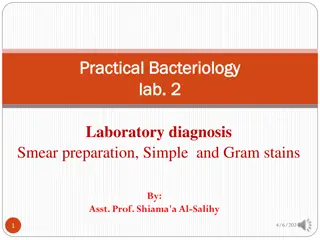Laboratory Sample Intake and Processing Procedures
Efficiently manage sample intake and processing in your laboratory with these supplemental materials. From submission checklists to sample preparation guidelines, ensure accurate analyses by following these organized procedures. Capture essential information through submission forms, labeling standards, and packaging instructions, enhancing lab efficiency and data integrity.
Download Presentation

Please find below an Image/Link to download the presentation.
The content on the website is provided AS IS for your information and personal use only. It may not be sold, licensed, or shared on other websites without obtaining consent from the author.If you encounter any issues during the download, it is possible that the publisher has removed the file from their server.
You are allowed to download the files provided on this website for personal or commercial use, subject to the condition that they are used lawfully. All files are the property of their respective owners.
The content on the website is provided AS IS for your information and personal use only. It may not be sold, licensed, or shared on other websites without obtaining consent from the author.
E N D
Presentation Transcript
LABORATORY MANAGEMENT Sample Intake and Processing Supplemental materials for Good Laboratory Management Training Manual for Trainers Prepared by Richard Fethiere, University of Florida FEED THE FUTURE INNOVATION LAB FOR LIVESTOCK SYSTEMS Photo Credit Goes Here
Sample intake and processing Submission checklist Sample information Background Services/analyses offered Description of analyses services offered Sample processing
SAMPLE INTAKE AND PROCESSING Lab contact information: A submission form (Form 1) must be available to gather contact information on the person submitting samples to the lab This form will collect the following info from the potential client or researcher: Date, researcher name, address, telephone, e-mail, type of sample material submitted, total number of samples submitted, analysis requested, total cost for the samples , this position of samples, account number for payment and forage lab (FL) set number This submission form will also allow the lab to keep track of the samples and their logbook
SUBMISSION CHECKLIST Sample preparation for nutritive value analyses All samples should be dried at 60 C and ground through a 1-millimeter screen. Any material left on the screen should be rerun, not discarded or returned into the sample as particle size will greatly affect results Sample Packaging Place samples in 7oz whirl pack bag only. Fill bag approximately halfway (between 10 and 25 grams). Bags with either too little or too much sample will make it difficult to obtain a representative sample for analysis Sample Labeling Use a sharpie, magic marker, or other permanent marker to write the sample number directly in the sample bag. Write the numbers on the bottom half of the bag Sample numbering Number all samples in the experiment from one to N. For experiments larger than 400 samples please contact the lab manager to decide on how to organize samples
SAMPLE INFORMATION This submission form will gather information on name of trial or essay, date on which the trial/essay was conducted, name of researcher, simple description for each sample, sequential sample number, replication number in the field, species/tissue type, treatment description The submission form allows the laboratory to record information on the samples submitted as well as the different treatments that were applied to the samples This information will serve as a record for the lab and for the researcher submitting the samples. This information will also be useful to the lab technicians to validate the results of the analysis
SERVICES / ANALYSES OFFERED Wet chemistry (price per test, not per sample) Dry matter Organic Matter Total Nitrogen Total Phosphorus In vitro Organic Matter Digestion
SERVICES / ANALYSES OFFERED Method used is a modification of the standard Kjeldahl procedure = Value represents total N (Organic and inorganic) Analysis of digestate done with Technicon Autoanalyzer at the Ruminant Nutrition Lab (AS) Total Nitrogen Nitrogen (N) is reported as elemental N as a percentage of DM Digestions are conducted at FESL
SAMPLE PROCESSING Samples are transferred into sample boxes, which are also assigned to the same FL # FL # and As samples arrive at laboratory Form 1 for this set is assigned a FL # corresponding info are transferred to logbook In the logbook, the following info is recorded as samples are received: FL#, # of samples received, researcher name, date of sample reception, experiment description, codes, analyses/procedures requested
Consult the Good Laboratory Management Training Manual for Trainers https://livestocklab.ifas.ufl.edu/resources/glp/ Direct link to manual in PDF: https://livestocklab.ifas.ufl.edu/media/livestocklabifasufledu/pdf-/MANUAL- Fethiere_UF_Good-lab-management-practices_2022.pdf
Feed the Future Innovation Lab for Livestock Systems https://livestocklab.ifas.ufl.edu/ (Subscribe to newsletter) livestock-lab@ufl.edu Disclaimer This work was funded by the United States Agency for International Development (USAID) Bureau for Food Security under Agreement #AID-OAA-L-15-00003 as part of Feed the Future Innovation Lab for Livestock Systems, and by the Bill & Melinda Gates Foundation OPP#1175487. Any opinions, findings, conclusions, or recommendations expressed here are those of the authors alone.























